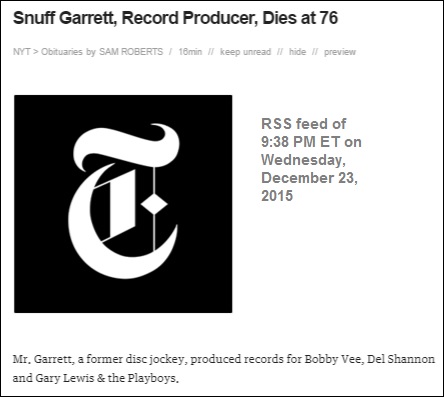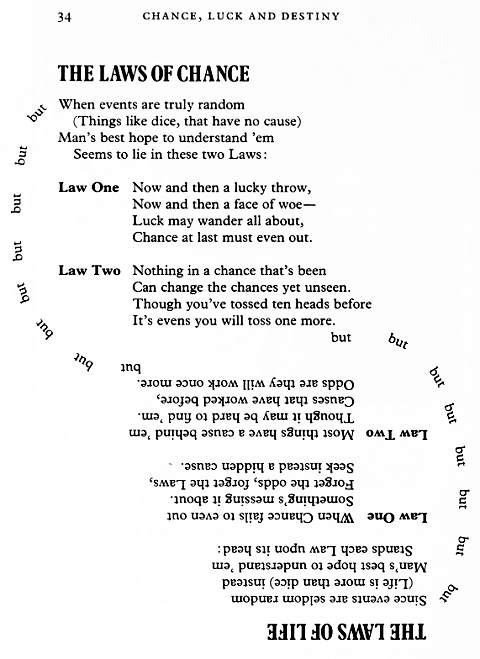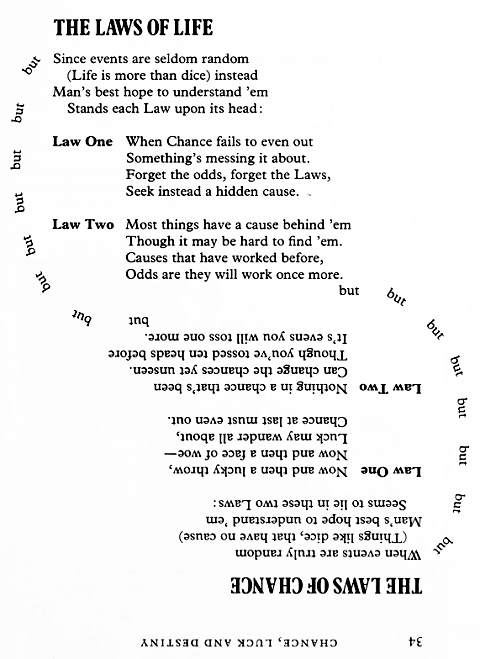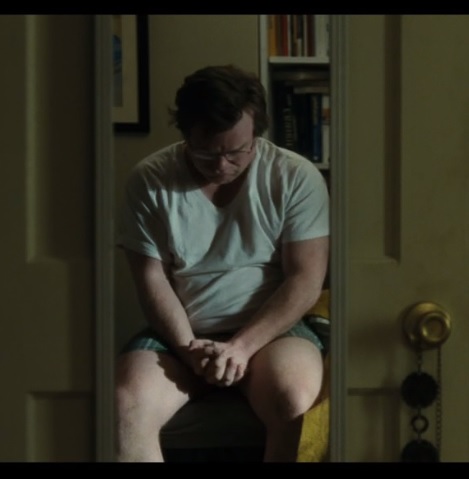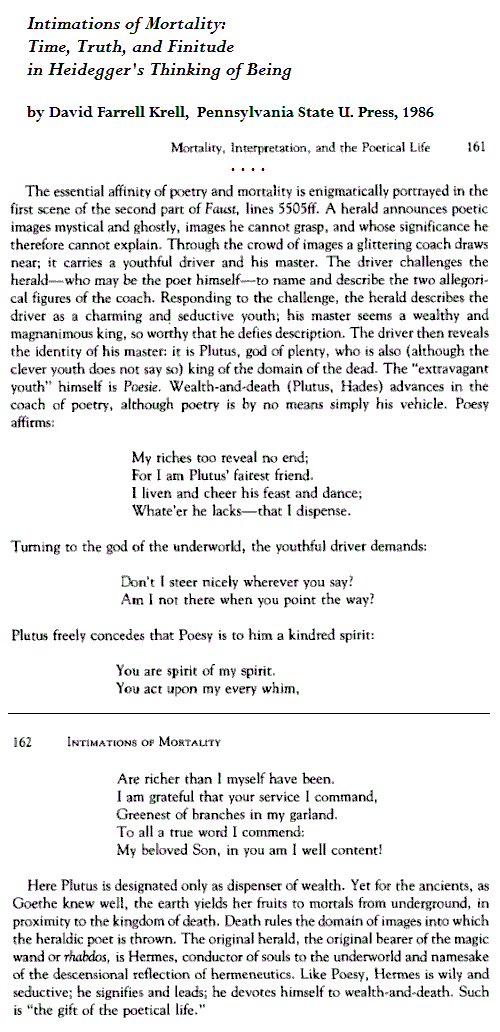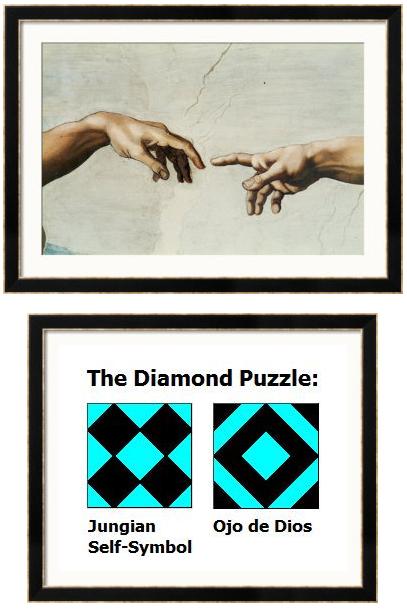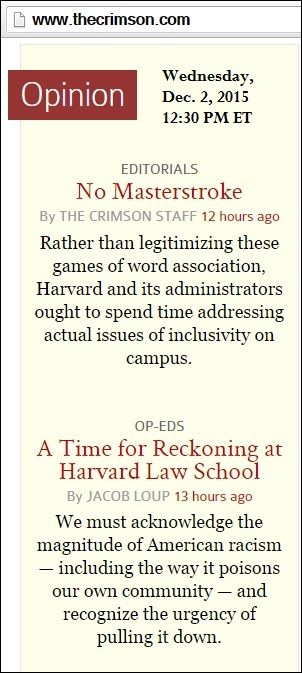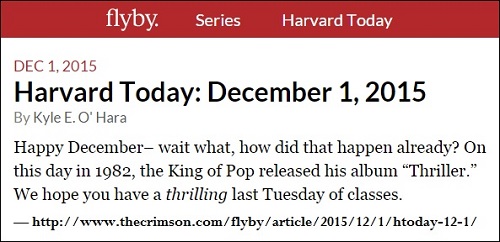(Continued from this date last year,
"Spiel ist nicht Spielerei. ")
Thursday, December 31, 2015
High Concept
Wednesday, December 30, 2015
Painting the News
"His paintings weren’t a kind of art.
They seemed to present themselves as
art in essence, immaculately conceived.
They made me feel, precisely, dumb,
with nothing to say."
— Peter Schjeldahl today on the late
Ellsworth Kelly
Robbing Peter to Pay Paul continues …
"He must know somethin',
but don't say nothin'."
Another Show
On the exit of an historian from the academic
stage on Sunday, December 13, 2015 —
Inverse Image
The previous post discussed some art related to the
deceptively simple concept of "four colors."
For other related material, see posts that contain a link
to "…mapsys.html."
Tuesday, December 29, 2015
Four and Four
A passage linked to here on the afternoon of Dec. 6, 2015 —
|
From news.artnet.com, Dec. 16, 2014 — "Kosuth's early roots were in analytical philosophy, and his neons fiddle with that legacy: it's language that considers the nature of language as it describes the world—as it makes meaning and creates objects. So the earliest here, Five Fives (to Donald Judd) , from 1965, is five rows of five words, of the numbers one through to 25 which stack up like bricks in an unfinished wall. Like the nearby phrase "An Object Self-Defined" (Self-Defined Object [green], 1966), or the four colored words of Four Colours Four Words (1966) it's a test of the relationship of a thing to an idea to a word. These texts short-circuit the question of how visual art relates to how we speak about it, dating from a period when modern art had gotten stuck with a certain idea of what modern art should look like, and how it should be talked about." |
Monday, December 28, 2015
Fuse
"Tell me the news, something I can use
Something red hot to light my fuse"
— Motörhead, "Bad Magic" album
Illustration from Oct. 25, 2013.
ART WARS Continues
Combining two headlines from this morning’s
New York Times and Washington Post , we have…
Deceptively Simple Geometries
on a Bold Scale
Voilà —
Click image for details.
More generally, see
Boole vs. Galois.
Mirrors, Mirrors, on the Wall
The previous post quoted Holland Cotter's description of
the late Ellsworth Kelly as one who might have admired
"the anonymous role of the Romanesque church artist."
Work of a less anonymous sort was illustrated today by both
The New York Times and The Washington Post —
The Post 's remarks are of particular interest:
|
Philip Kennicott in The Washington Post , Dec. 28, 2015, “Sculpture for a Large Wall” consisted of 104 anodized aluminum panels, colored red, blue, yellow and black, and laid out on four long rows measuring 65 feet. Each panel seemed different from the next, subtle variations on the parallelogram, and yet together they also suggested a kind of language, or code, as if their shapes, colors and repeating patterns spelled out a basic computer language, or proto-digital message. The space in between the panels, and the shadows they cast on the wall, were also part of the effect, creating a contrast between the material substance of the art, and the cascading visual and mental ideas it conveyed. The piece was playful, and serious; present and absent; material and imaginary; visually bold and intellectually diaphanous. Often, with Kelly, you felt as if he offered up some ideal slice of the world, decontextualized almost to the point of absurdity. A single arc sliced out of a circle; a single perfect rectangle; one bold juxtaposition of color or shape. But when he allowed his work to encompass more complexity, to indulge a rhetoric of repetition, rhythmic contrasts, and multiple self-replicating ideas, it began to feel like language, or narrative. And this was always his best mode. |
Compare and contrast a 2010 work by Josefine Lyche —
Lyche's mirrors-on-the-wall installation is titled
"The 2×2 Case (Diamond Theorem)."
It is based on a smaller illustration of my own.
These variations also, as Kennicott said of Kelly's,
"suggested a kind of language, or code."
This may well be the source of their appeal for Lyche.
For me, however, such suggestiveness is irrelevant to the
significance of the variations in a larger purely geometric
context.
This context is of course quite inaccessible to most art
critics. Steve Martin, however, has a phrase that applies
to both Kelly's and Lyche's installations: "wall power."
See a post of Dec. 15, 2010.
Sunday, December 27, 2015
Rigorous
Symbol —
Monday, November 7, 2011
|
Saturday, December 26, 2015
Midnight Reflection
Friday, December 25, 2015
At Play in the Fields
See Fields of Force and recent posts.
From PR Newswire in July 2011 —
Campus Crusade for Christ Adopts New Name: Cru
60-year-old Int’l Ministry Aims to Increase
Relevance and Global Effectiveness

Related material:
Dark Symbol
Related material:
The previous post (Bright Symbol) and
a post from Wednesday,
December 23, 2015, that links to posts
on Boolean algebra vs. Galois geometry.
"An analogy between mathematics and religion is apposite."
— Harvard Magazine review by Avner Ash of
Mathematics without Apologies
(Princeton University Press, January 18, 2015)

Thursday, December 24, 2015
Wednesday, December 23, 2015
Style
(Continued from December 16, 2015)
The New York Times obituary this evening
of a record producer —
"Mr. Garrett signed Gary Lewis & the Playboys in 1964
after discovering them performing at Disneyland.
(Mr. Lewis is the son of the comedian and actor Jerry Lewis.)
The group’s recording of 'This Diamond Ring' reached the top
of the Billboard singles chart in 1965 and sold more than
a million copies." — Sam Roberts in The New York Times
From a Log24 post on the reported date of Mr. Garrett's death —
"That's it, baby, when you've got it, flaunt it, flaunt it!"
— Zero Mostel
Class of 64
The previous post dealt with one of the 64 symbols
(in a redesigned format) of the ancient Chinese classic
The I Ching .
For those who prefer to be guided by programmed
responses to alphabetical symbols …
A lyric by Ira Gershwin —

A cinematic "T" —
See also "T for Texas" in this journal and
George Clooney's recent attempt to commercialize
both the space program and the letter Omega:
From a post of May 13, 2015 —
Splitting Apart
Analogy
"An analogy between mathematics and religion is apposite."
— Harvard Magazine review by Avner Ash of
Mathematics without Apologies
(Princeton University Press, January 18, 2015)
See as well Analogies in this journal.
Mark
"Condescension and a certain amount of hostility
used to mark the critical reaction…."
— Emma Brockes on Stephen King in
The Guardian , 21 Sept. 2013
For the mark itself, see Black Swan Venus,
Vonnegut Asterisk, and Branding Iron.

Tuesday, December 22, 2015
Bell de Jour
This journal on Saturday, Dec. 19 —
|
“By groping toward the light we are made to realize how deep the darkness is around us.” — Arthur Koestler, The Call Girls: A Tragi-Comedy, Random House, 1973, page 118 |
In memory of Madame Claude, who
reportedly died in Nice December 19:
"There were fairies and spirits."
Amen.
Goal
Quoted by physics writer Heinz Pagels
at the end of The Cosmic Code :
“For the essence and the end
Of his labor is beauty… one beauty,
the rhythm of that Wheel….”
— Robinson Jeffers
Boulevard of Broken Punchlines
How Deep the Darkness
See Bauhaus remarks on space and Devil's Night Eve.
See also Klein Group and, for the Harvard Graduate
School of Design, an appropriate Calvin Klein label —

Monday, December 21, 2015
The Eppstein Edit
A Wikipedia edit today by David Eppstein, a professor
at the University of California, Irvine:
See the Fano-plane page before and after the Eppstein edit.
Eppstein deleted my Dec. 6 Fano 3-space image as well as
today's Fano-plane image. He apparently failed to read the
explanatory notes for both the 3-space model and the
2-space model. The research he refers to was original
(in 1979) but has been published for some time now in the
online Encyclopedia of Mathematics, as he could have
discovered by following a link in the notes for the 3-space
model.
For a related recent display of ignorance, see Hint of Reality.
Happy darkest night.
Oral-Aural
See also the Eve of Devil's Night, 2015 —
Related material from an academic's weblog —
Happy birthday to a star of Tarantino's Yuletide offering.
ART WARS (continued)
Today in History —
"On December 21, 1937, 'Snow White and the Seven Dwarfs'
premiered to a record-breaking audience at the Carthay Circle
Theatre in Los Angeles."
Related material: Today's previous post and the Red Book.
Slouching Towards Christmas (continued)
Under the Volcano:
A Bottle, a Door, a Box

See also Glory Season (Nov. 12, 2005) and Unique Figure (April 12, 2011).
Update of 11:22 AM —
Today in History —
"On December 21, 1937, 'Snow White and the Seven Dwarfs'
premiered to a record-breaking audience at the Carthay Circle
Theatre in Los Angeles."
Related material: The Red Book.
Sunday, December 20, 2015
Saturday, December 19, 2015
Nunc Stans
On conductor Kurt Masur, who reportedly died at 88
in Greenwich, Connecticut, today, Saturday, Dec.19, 2015 —
"Rehearsal conductor at Halle State Theater,
Saxony, East Germany, conductor at Erfurt City Theater
and Leipzig Opera, and guest conductor with Leipzig
and Dresden Radio orchestras, 1951-53…."
Motifs from yesterday's 9 PM post —

Design from 1697
— and from a novel by Thomas Mann:
Design from 1514
Related text —
Friday, December 18, 2015
Box of Nothing
Images related to the previous post —


Detail of the 1697 Leibniz medal
|
“And so that I won’t come entirely empty-handed this time, I enclose a design of that which I had the pleasure of discussing with you recently. It is in the form of a memorial coin or medallion; and though the design is mediocre and can be improved in accordance with your judgment, the thing is such, that it would be worth showing in silver now and unto future generations, if it were struck at your Highness’s command. Because one of the main points of the Christian Faith, and among those points that have penetrated least into the minds of the worldly-wise and that are difficult to make with the heathen is the creation of all things out of nothing through God’s omnipotence, it might be said that nothing is a better analogy to, or even demonstration of such creation than the origin of numbers as here represented, using only unity and zero or nothing. And it would be difficult to find a better illustration of this secret in nature or philosophy; hence I have set on the medallion design IMAGO CREATIONIS [in the image of creation]. It is no less remarkable that there appears therefrom, not only that God made everything from nothing, but also that everything that He made was good; as we can see here, with our own eyes, in this image of creation. Because instead of there appearing no particular order or pattern, as in the common representation of numbers, there appears here in contrast a wonderful order and harmony which cannot be improved upon…. Such harmonious order and beauty can be seen in the small table on the medallion up to 16 or 17; since for a larger table, say to 32, there is not enough room. One can further see that the disorder, which one imagines in the work of God, is but apparent; that if one looks at the matter with the proper perspective, there appears symmetry, which encourages one more and more to love and praise the wisdom, goodness, and beauty of the highest good, from which all goodness and beauty has flowed.” |
See also some related posts in this journal.
Sequel
A prequel to the 2013 film "The Zero Theorem" —
"Down below, infinitely deep into the blackness,
things were beginning. The blackness had
arranged itself into a whirlpool…."
— Peter Dickinson, A Box of Nothing (1985),
"Chapter 19: Star Tree"
— may serve as a sequel to the life of the book's author.
(See Dickinson Sequel in this journal.)
Thursday, December 17, 2015
S-Curves by Peter Dickinson
British author Peter Dickinson, who reportedly died yesterday,
Dec. 16, 2015, at 88, wrote the following (published in the UK
in 1975 and in the US in 1976) —
Inverted image of the above page —
See also, from the date of Dickinson's death, a post on
"A Fight for the Soul…" and a post on the symbol "S."
Of interest too are some remarks related to today's earlier post,
"Hint of Reality" …
Hint of Reality
From an article* in Proceedings of Bridges 2014 —
|
As artists, we are particularly interested in the symmetries of real world physical objects. Three natural questions arise: 1. Which groups can be represented as the group of symmetries of some real-world physical object? 2. Which groups have actually been represented as the group of symmetries of some real-world physical object? 3. Are there any glaring gaps – small, beautiful groups that should have a physical representation in a symmetric object but up until now have not? |
The article was cited by Evelyn Lamb in her Scientific American
weblog on May 19, 2014.
The above three questions from the article are relevant to a more
recent (Oct. 24, 2015) remark by Lamb:
"… finite projective planes [in particular, the 7-point Fano plane,
about which Lamb is writing] seem like a triumph of purely
axiomatic thinking over any hint of reality…."
For related hints of reality, see Eightfold Cube in this journal.
* "The Quaternion Group as a Symmetry Group," by Vi Hart and Henry Segerman
Wednesday, December 16, 2015
Soul Notes
See pages 36 and 37 of Suzanne Gieser's The Innermost Kernel
as well as PyrE in The Stars My Destination and Old St. Patrick's*
in "Gangs of New York."
For some related aesthetic remarks, see a New Yorker essay
published onlne today and this journal's previous post.
* The older version of the "Old St. Patrick's"
of The Stars My Destination . (Update of 4/21/16.)
The Jewel in the Lotus…
Meets the Kernel in the Nutshell.
This post was suggested by the title of Natalie Wolchover’s
article in Quanta Magazine today,
“A Fight for the Soul of Science.”
The post continues a meditation on the number 6
as the kernel in the nutshell of 15.
For an illustration of the 6 in the 15,
see nocciolo in this journal.
For an illustration of the jewel in the lotus,
see that phrase in this journal.
Board Awards
S is for Style
In memory of "a phenomenal merchandiser"
who reportedly died on Monday, Dec. 14, 2015:
Click on image for some backstory.
Tuesday, December 15, 2015
Jews on Style
Square Triangles
Click image for some background.
Exercise: Note that, modulo color-interchange, the set of 15 two-color
patterns above is invariant under the group of six symmetries of the
equilateral triangle. Are there any other such sets of 15 two-color triangular
patterns that are closed as sets , modulo color-interchange, under the six
triangle symmetries and under the 322,560 permutations of the 16
subtriangles induced by actions of the affine group AGL(4,2)
on the 16 subtriangles' centers , given a suitable coordinatization?
Surrealistic Alarm Clock*
Monday, December 14, 2015
The Forking
From the previous post:
"Neat, Dr. Walker, thought Peter Slater—
neat, and totally without content."
— Paul Preuss's 1983 novel Broken Symmetries
A background check yields …
"Dr. Evan Harris Walker died on the evening of
August 17, 2006…."
A synchronicity check of that date in this journal yields a diagram
that, taken by itself, is "neat, and totally without content." —

The diagram may be viewed as a tribute
to the late Yogi Berra, to the literary
"Garden of Forking Paths," or, more
seriously, to the modular group Γ.
Dirac and Geometry
See a post by Peter Woit from Sept. 24, 2005 — Dirac's Hidden Geometry.
The connection, if any, with recent Log24 posts on Dirac and Geometry
is not immediately apparent. Some related remarks from a novel —
|
From Broken Symmetries by Paul Preuss "He pondered the source of her fascination with the occult, which sooner or later seemed to entangle a lot of thoughtful people who were not already mired in establishmentarian science or religion. It was the religious impulse, at base. Even reason itself could function as a religion, he supposed— but only for those of severely limited imagination. He’d toyed with 'psi' himself, written a couple of papers now much quoted by crackpots, to his chagrin. The reason he and so many other theoretical physicists were suckers for the stuff was easy to understand— for two-thirds of a century an enigma had rested at the heart of theoretical physics, a contradiction, a hard kernel of paradox. Quantum theory was inextricable from the uncertainty relations. The classical fox knows many things, but the quantum-mechanical hedgehog knows only one big thing— at a time. 'Complementarity,' Bohr had called it, a rubbery notion the great professor had stretched to include numerous pairs of opposites. Peter Slater was willing to call it absurdity, and unlike some of his older colleagues who, following in Einstein’s footsteps, demanded causal explanations for everything (at least in principle), Peter had never thirsted after 'hidden variables' to explain what could not be pictured. Mathematical relationships were enough to satisfy him, mere formal relationships which existed at all times, everywhere, at once. It was a thin nectar, but he was convinced it was the nectar of the gods. The psychic investigators, on the other hand, demanded to know how the mind and the psychical world were related. Through ectoplasm, perhaps? Some fifth force of nature? Extra dimensions of spacetime? All these naive explanations were on a par with the assumption that psi is propagated by a species of nonlocal hidden variables, the favored explanation of sophisticates; ignotum per ignotius . 'In this connection one should particularly remember that the human language permits the construction of sentences which do not involve any consequences and which therefore have no content at all…' The words were Heisenberg’s, lecturing in 1929 on the irreducible ambiguity of the uncertainty relations. They reminded Peter of Evan Harris Walker’s ingenious theory of the psi force, a theory that assigned psi both positive and negative values in such a way that the mere presence of a skeptic in the near vicinity of a sensitive psychic investigation could force null results. Neat, Dr. Walker, thought Peter Slater— neat, and totally without content. One had to be willing to tolerate ambiguity; one had to be willing to be crazy. Heisenberg himself was only human— he’d persuasively woven ambiguity into the fabric of the universe itself, but in that same set of 1929 lectures he’d rejected Dirac’s then-new wave equations with the remark, 'Here spontaneous transitions may occur to the states of negative energy; as these have never been observed, the theory is certainly wrong.' It was a reasonable conclusion, and that was its fault, for Dirac’s equations suggested the existence of antimatter: the first antiparticles, whose existence might never have been suspected without Dirac’s crazy results, were found less than three years later. Those so-called crazy psychics were too sane, that was their problem— they were too stubborn to admit that the universe was already more bizarre than anything they could imagine in their wildest dreams of wizardry." |
Particularly relevant …
"Mathematical relationships were enough to satisfy him,
mere formal relationships which existed at all times,
everywhere, at once."
Some related pure mathematics —
Sunday, December 13, 2015
Another Opening, Another Show
Ben Brantley in tonight's online review of a show that
reportedly opened off-Broadway on Dec. 10, 2015 —
" 'Mattress' has its charms, but they do wear thin. "
See also The New York Times on Martin Gardner Nov. 30:
A companion image from this journal
on the "Mattress" opening date —

Midrash:
Vonnegut Asterisk
The Monster as Big as the Ritz
"The colorful story of this undertaking begins with a bang."
— Martin Gardner on the death of Évariste Galois
Saturday, December 12, 2015
Take This, Waltz
An excerpt from http://yarchive.net/med/middle_ages.html —
From: ((Steven B. Harris)) Subject: Re: Problems with sci.med.aids FAQ (section 7) Part II Date: 09 Jun 1995 In <173AD1188AS85.AVIRAMA@UNIVSCVM.CSD.SCAROLINA.EDU> AVIRAMA@UNIVSCVM.CSD.SCAROLINA.EDU (Amittai F. Aviram) writes to David Mertz: >Ahem.... With all due respect, it seems to me to make no sense >to criticize a scientist or medical doctor for "a childish >little schoolboy positivism." Well, I think he was referring to the Vienna School, where the schoolboys shout childish things like "Your mother still believes in Compte!" and "Well, at least my mother has values and isn't a logical empiricist like YOUR old man!" Woody Allen went there, but says he was expelled during a philosophy test for looking into the soul of the kid next to him.
Midrash —
"There's a concert hall in Vienna
Where your mouth had a thousand reviews"
— Leonard Cohen lyric, "Take This Waltz"
Synchronicity check:
Friday, December 11, 2015
“Ask for help in the morning”
Science and Opinion
For readers of recent Log24 posts mentioning artificial intelligence
(Church for Rebecca) and Pluto (Street View) —
— Times Wire this afternoon
The post mentioning Pluto contained David Farrell Krell's
misleading conflation of Goethe's "Plutus, god of plenty"
with Pluto, "king of the domain of the dead."
For some background on Plutus, see Wikipedia.
For some background on Pluto by an author I much prefer to Krell,
see A Shadow for Groundhog Day (this journal, February 2, 2014).
Charm School
Continued from November 26.
“She was absolutely magical.”
The above quote is from the obituary of a British actress.
Her birth date was July 19. Her death date was November 25.
Spoilers
In memory of Michael Crichton, Harvard '64.
Those who have not yet seen the 1956 classic Forbidden Planet
should skip this post. For those who know and love it, here is an
aide-mémoire .
Street View
Continued from Once Upon a Matrix (November 27, 2015).

Click image below to enlarge.
“… Which makes it a gilt-edged priority that one of us
gets into that Krell lab and takes that brain boost.”
— American adaptation of Shakespeare's Tempest , 1956
Midrash —
"Remember me to Herald Square."
Thursday, December 10, 2015
Art Brut?
Strange Myths
Peter Schjeldahl in the current (Dec. 14) New Yorker :
The phrase “outsider art” was coined in 1972 by a
British art historian, Roger Cardinal, to translate
the sense of “art brut ,” which Dubuffet had
considered rendering as art “raw,” “uncouth,” “crude,”
or “in the rough.” But the term misses the full thrust
of Dubuffet’s elevation of “people uncontaminated
by artistic culture,” as he called them. He aspired not
to make outsiders respectable but to destroy the
complacency of insiders. He disqualified even tribal
and folk artists, and spirited amateurs like Henri
Rousseau, for being captive to one tradition or another.
Art brut must be sui generis, from the hands and minds
of “unique, hypersensitive men, maniacs, visionaries,
builders of strange myths.”
The literary art of Fritz Leiber and Stephen King seems to
fit this definition.
Somewhat less brut — the literary art of Plato.
A non-literary illustration:

Time as "a moving
image of eternity.”
— Plato
Wednesday, December 9, 2015
Event
"Bauhaus Designs for Modern Life —
Come to the Harvard Art Museums
for this Gallery Talk at 12:30."
Another design —
Street view in Oslo, August 2014 :

Take a walk on the wild side… or not.
Eternity (Not by Calvin Klein*)
The two symbols on the monolith

may, if one likes, be interpreted
as standing for Damnation Morning
and for the Windmill of Time.
* "Award-winning fashion icon."
— Harvard Graduate School of Design
Tuesday, December 8, 2015
It’s 10 PM.
"There is a place for a hint somewhere
of a big agent, to complete the picture."
— F. Scott Fitzgerald, The Last Tycoon
Never Stop Exploring.

"And we may see the meadow in December…."
Little Kay was quite blue, yes nearly black with cold;
but he did not observe it, for she had kissed away
all feeling of cold from his body, and his heart was
a lump of ice. He was dragging along some pointed
flat pieces of ice, which he laid together in all possible
ways, for he wanted to make something with them;
just as we have little flat pieces of wood to make
geometrical figures with, called the Chinese Puzzle.
Kay made all sorts of figures, the most complicated,
for it was an ice-puzzle for the understanding.
In his eyes the figures were extraordinarily beautiful,
and of the utmost importance; for the bit of glass
which was in his eye caused this. He found whole
figures which represented a written word; but he
never could manage to represent just the word
he wanted–that word was "eternity"; and the
Snow Queen had said, "If you can discover that figure,
you shall be your own master, and I will make you
a present of the whole world and a pair of new skates."
But he could not find it out.
— From The Snow Queen , by Hans Christian Andersen
See also the Chinese Puzzle in the previous post.
Lights, Camera, van Doesburg!
Click image below for some conceptual differences
between Mondrian (previous post) and van Doesburg.
The image is from the post "Janet's Tea Party"
of November 20, 2004.
Conceptual Art
A December 7th New York Times column:
A current exhibition by Joseph Kosuth in Oslo:
From the two texts by Mondrian at the right hand of Kosuth —
"The positive and negative states of being bring about action."
"Through its pure relationships, purely abstract art
can approach the expression of the universal …."
These texts may be viewed as glosses on the following image —
Click image for related posts.
Church for Rebecca
"Remember, Genesis IS Skynet."
Bloomberg News today:
Why 2015 Was a Breakthrough Year in Artificial Intelligence
"Computers are 'starting to open their eyes,' said a senior fellow at Google."
Monday, December 7, 2015
Neon Joe, Werewolf Hunter
For the title, see The New York Times and the oeuvre of Joseph Kosuth.
|
From The Dreaming Jewels , by Theodore Sturgeon: "Oh. And the crystals make things — even complete things — like Tin Pan Alley makes songs." "Something like it." Zena smiled. It was the first smile in a long while. "Sit down, honey; I'll bring the toast. Now — this is my guess — when two crystals mate, something different happens. They make a whole thing. But they don't make it from just anything the way the single crystals do. First they seem to die together. For weeks they lie like that. After that they begin a together-dream. They find something near them that's alive, and they make it over. They replace it, cell by cell. You can't see the change going on in the thing they're replacing. It might be a dog; the dog will keep on eating and running around; it will howl at the moon and chase cats. But one day — I don't know how long it takes — it will be completely replaced, every bit of it." "Then what?" "Then it can change itself — if it ever thinks of changing itself. It can be almost anything if it wants to be." Bunny stopped chewing, thought, swallowed, and asked, "Change how?" "Oh, it could get bigger or smaller. Grow more limbs. Go into a funny shape — thin and flat, or round like a ball. If it's hurt it can grow new limbs. And it could do things with thought that we can't even imagine. Bunny, did you ever read about werewolves?" "Those nasty things that change from wolves to men and back again?" Zena sipped coffee. "Mmm. Well, those are mostly legends, but they could have started when someone saw a change like that." |
See as well The Dreaming Jewels
and "Steven Universe" in this journal.
You can't make this stuff up.
McGinn Illustrated
Wittgenstein Illustrated
From "AMNESIA: VARIOUS, LUMINOUS, FIXED,"
An exhibition by Joseph Kosuth at
Sprüth Magers Gallery London,
NOVEMBER 26 2014 – FEBRUARY 14 2015 —
This journal, NOVEMBER 26 2014 –
|
Wednesday, November 26, 2014
Mathematics and Narrative
|
This journal, FEBRUARY 14 2015 —
Sunday, December 6, 2015
American Hustlers
A Log24 Hanukkah from five years ago (Dec. 5, 2010) —
Related material: Oslo artist Josefine Lyche's
private Instagram photo of her adolescence with
a ZX Spectrum, and Symbols, Local and Global.
Form and Idea
"Those early works are succinct and uncompromising
in how they give shape to the philosophical perplexities
of form and idea…."
J. J. Charlesworth, artnet news, Dec. 16, 2014
"Form" and "idea" are somewhat synonymous,
as opposed to "form" and "substance." A reading:
Saturday, December 5, 2015
Sabbath School
Friday, December 4, 2015
Symbology for the Vatican Gift Shop
(Title adapted from a 1996 Stone Temple Pilots album)
See Symbols, Local and Global (September 26, 2015),
Change Descends (April 11, 2014), and Altar (August 27, 2014).
Turntable
André Weil in a letter to his sister —
"I spoke of a bridge; it would be more correct
to speak of a turntable."
Click the above image for a post from 10 years ago today.
Scholium
"Encouraged by Proposition 5, one may hope…."
— Katrin Wendland in the previous post
Related material: Euclid Book I, Proposition 5.
Thursday, December 3, 2015
Overarching Symmetry
From p. 34 of the preprint "Snapshots of Conformal Field Theory,"
by Katrin Wendland, arXiv, 11 April 2014 —

50. Gannon, T.: Much ado about Mathieu (arXiv:1211.5531 [math.RT])
85. Taormina, A., Wendland, K.: The overarching finite symmetry group
of Kummer surfaces in the Mathieu group M24. JHEP 08, 125 (2013)
86. Taormina, A., Wendland, K.: Symmetry-surfing the moduli space
of Kummer K3s (arXiv:1303.2931 [hep-th])
87. Taormina, A., Wendland, K.: A twist in the M24 moonshine story
(arXiv:1303.3221 [hep-th])
The Wendland paper was published on Jan. 7, 2015, in
Mathematical Aspects of Quantum Field Theories ,
edited by Damien Calaque and Thomas Strobl
(Springer Mathematical Physics Studies), pages 89-129.
Design Wars
"… if your requirement for success is to be like Steve Jobs,
good luck to you."
— "Transformation at Yahoo Foiled by Marissa Mayer’s
Inability to Bet the Farm," New York Times online yesterday
"Design is how it works." — Steve Jobs
Related material: Posts tagged Ambassadors.

Wednesday, December 2, 2015
Art Wars
In memory of art dealer Leslie Waddington, who
reportedly died at 81 on St. Andrew's Day, 2015,
a search for "Terry Frost" in this journal.
Tuesday, December 1, 2015
Verhexung*
"The positional meaning of a symbol derives from
its relationship to other symbols in a totality, a Gestalt,
whose elements acquire their significance from the
system as a whole."
— Victor Turner, The Forest of Symbols , Ithaca, NY,
Cornell University Press, 1967, p. 51, quoted by
Beth Barrie in "Victor Turner."
(Turner pioneered the use of the term "symbology,"
a term later applied by Dan Brown to a fictional
scholarly pursuit at Harvard.)
* A scholarly pursuit at Hogwarts.
Brief Monologue
A possible antidote to Hamlet's glum remark in the previous post:
Fact check —
The Dec. 1 release date is that given in Michael Jackson:
King of Pop, by Mary K. Pratt (ABDO Publishing, 2010), pp. 58, 96.
Other sources give instead a release date of St. Andrew's Day, 1982:
The Nutshell
See a search for Nocciolo in this journal.
An image from that search —
Recall also Hamlet's
"O God… bad dreams."
Pascal’s Finite Geometry
See a search for "large Desargues configuration" in this journal.
The 6 Jan. 2015 preprint "Danzer's Configuration Revisited,"
by Boben, Gévay, and Pisanski, places this configuration,
which they call the Cayley-Salmon configuration , in the
interesting context of Pascal's Hexagrammum Mysticum .
They show how the Cayley-Salmon configuration is, in a sense,
dual to something they call the Steiner-Plücker configuration .
This duality appears implicitly in my note of April 26, 1986,
"Picturing the smallest projective 3-space." The six-sets at
the bottom of that note, together with Figures 3 and 4
of Boben et. al. , indicate how this works.

The duality was, as they note, previously described in 1898.


Related material on six-set geometry from the classical literature—
Baker, H. F., "Note II: On the Hexagrammum Mysticum of Pascal,"
in Principles of Geometry , Vol. II, Camb. U. Press, 1930, pp. 219-236
Richmond, H. W., "The Figure Formed from Six Points in Space of Four Dimensions,"
Mathematische Annalen (1900), Volume 53, Issue 1-2, pp 161-176
Richmond, H. W., "On the Figure of Six Points in Space of Four Dimensions,"
Quarterly Journal of Pure and Applied Mathematics , Vol. 31 (1900), pp. 125-160
Related material on six-set geometry from a more recent source —
Cullinane, Steven H., "Classical Geometry in Light of Galois Geometry," webpage









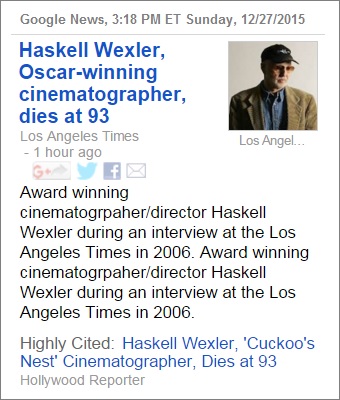


 .
.







